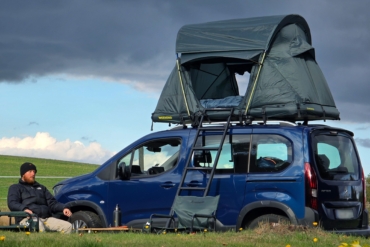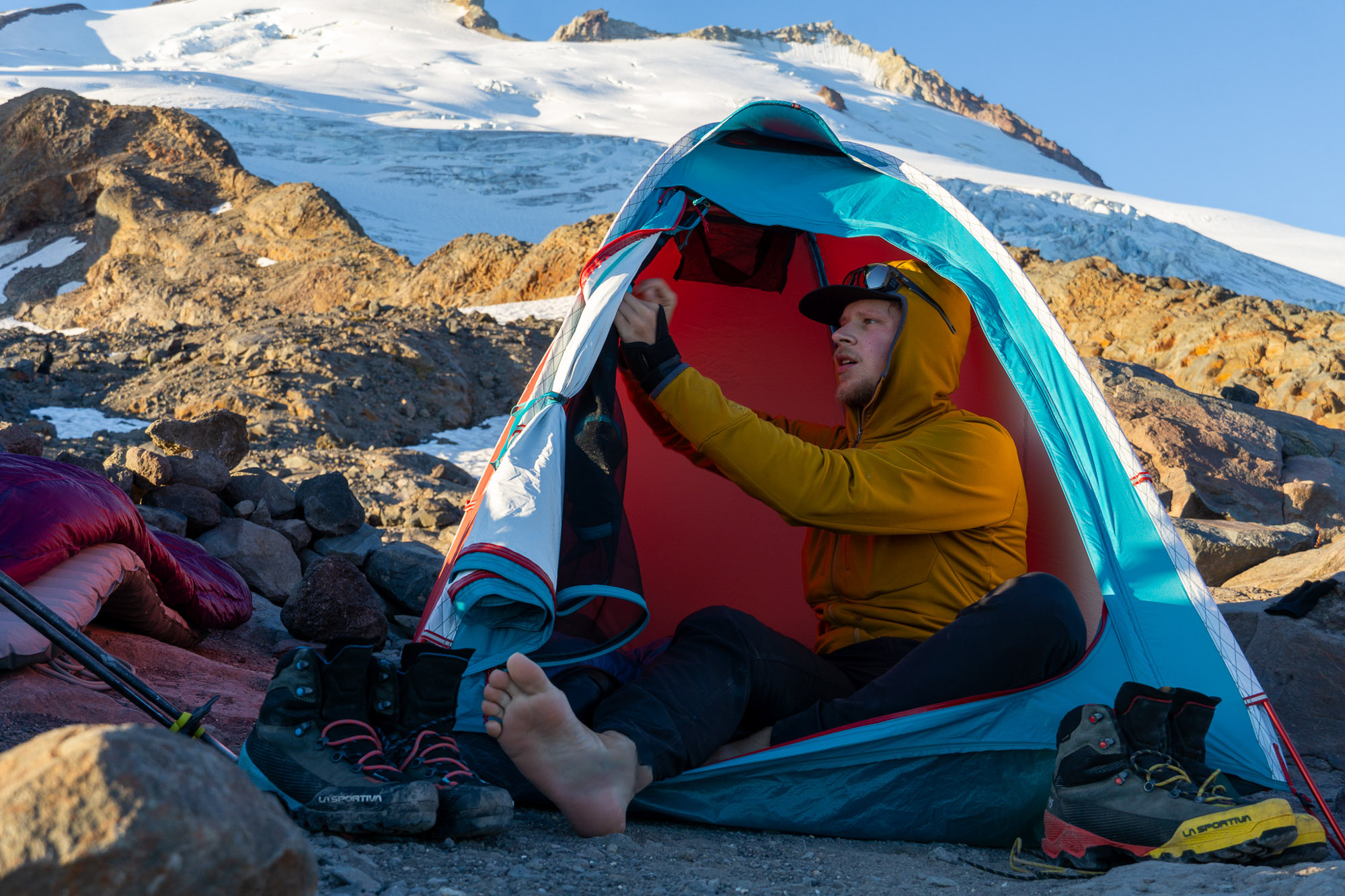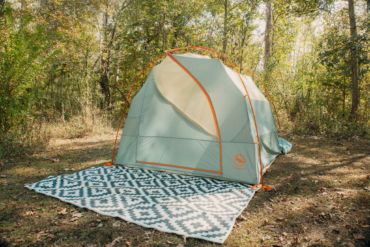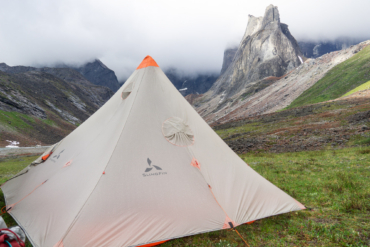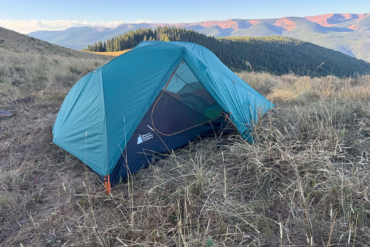Sea to Summit has a strong reputation for high-end sleeping pads, cook kits, and sleeping bags. But it has never manufactured camping tents — until now. We got our hands on the first Sea to Summit tent, the Telos TR2, for a quick first look.
It’s still the tail end of winter in Denver. But with a few warm spring days reinvigorating my stoke for camping, I was excited to check out a new tent with dreams of starry summer skies ruminating in my mind.
Sea to Summit has proven itself a strong player in the camping gear market. Could its tents measure up to its other products, such as one of the absolute best sleeping pads you can buy?

For spring 2021, Sea to Summit launches two tents, the Alto and Telos. While they look very similar to other leading tents at first glance, both have unique design features — particularly “Tension Ridge” pole construction — that differentiate them from the field. The brand claims the Tension Ridge alleviates two common pain points of modern tents: liveable space and ventilation.
So with the lightweight two-person Telos TR2 in hand, I headed to a local park with GearJunkie Editor-In-Chief Adam Ruggiero to set up and inspect this first tent from the brand and see firsthand.
In short: The Sea to Summit Telos TR2 is a light (3.6 pounds packed weight) two-person tent. It has a minimalistic but effective interior that maximizes usable space and comfort for backpacking. The tent uses quality materials like DAC poles and a 20-denier nylon floor.
It should be a great tent for those who backpack but want a tent durable enough to transition to car camping. And it has a few tricks up its sleeve. Read on for the details.
Sea to Summit Telos, Alto Tents
Sea to Summit’s first foray into freestanding tents (the brand has made tarp-based shelters in the past) takes a unique path.
The Telos, which we had a chance to inspect first-hand, allows multiple configurations, from typical freestanding tent with rainfly to fly-only setup ultralight mode and “hangout mode” (shown below), which allows folks to use it more as a sunshade for beach days or wherever. Check out the photo below in “hangout mode.”

But while that’s cool and something I could see using on occasion, I was most interested in examining the meat of the tent. For me, and most backpackers during the buggy summer months, that means the mesh interior and rainfly. How would the Telos measure up?
Telos 2 Person Tent First Look
Ruggiero and I decided, as usual, to not look at the instructions before setting up the Telos. We like to see how intuitive the tent is in the setup. And in this case, we were pleased. The Telos uses logical color-coding in its poles and hooks to make setup a breeze. Having never put it up before, we had the mesh tent body erected in about 2 minutes.

Once set up, the Telos 2 interior is pretty much what I expect from a quality backpacking tent. It’s long enough for Adam, who’s about 6’4″, to lay down straight. But we decided he’s about the maximum comfortable height for the tent. Any taller, and he’d have been hitting his head, feet, or both. And it’s wide enough for two adults, but plan on being cozy.
The Telos has a pretty minimalistic interior. You’ll find just two mesh pockets near your head, one for each camper, and a large gear loft that you need to attach inside for the first use. Once set up, I imagine most campers would just leave it in the tent, well, forever. It gives lots of space for things like gloves or hats.
The tent has two doors and vestibules, which should provide plenty of space for a backpack for each camper plus shoes and maybe a little more gear.

Now onto the Tension Ridge. The point of this design is to make the walls darned near vertical and give lots of space inside to sit up. And it really works well. Even at Adam’s height, he had plenty of room to sit up straight inside the tent. And the nearly vertical walls will keep dew-dampened fabric away from sleeping bags.
The design also allows campers to control ventilation well even with the vestibule closed. We didn’t have a chance to test this feature, but it looks very promising, with large vents on the top of the rainfly and tons of mesh inside.

Onto more mundane but important features, the nylon floor is seam-taped from the factory and comes up the sides in a nice bathtub construction. That will keep the rain at bay even when spattering on the sides of the floor. The Sil-Nylon fly gives a well-protected area of dryness that I expect would function well in rain, although we haven’t tested it for that just yet.
Long story short — and keep in mind this is just an initial impression after setting up the tent for an hour in a park — is that this will be a really good tent for two backpackers. It’s not “ultralight,” but it’s light enough for easy backpacking and should be reasonably durable, especially if you use a footprint (sold separately).
Finally, it’s worth noting that the Telos also sells in a three-person configuration. We also haven’t seen the Alto tent, which sells in one- and two-person configurations and also hits the market this month.
Sea to Summit Telos and Alto
I really liked the look of the Telos. It has a lot of unique design elements that make it an appealing tent that should be fairly versatile for a light three-season model. But I’m not yet sure how I feel about two admittedly clever design elements that make up the “Fair Share Storage System.”
The system is a cool idea meant to allow backpackers to break up the tent so each person carries part of it. First, the tent body and fly pack into two separate bags. The poles then go in their own sleeve.
I can see the appeal of this for those who may bring just the fly for ultralight camping. I also can see it as a nice way to share the weight on the trail. However, I also think it might get a little confusing keeping track of both stuff sacks, which to me were just large enough to perform their jobs well and not be too tight.
Second, the tent poles store inside a three-dimensional sleeve that doubles as a “light bar” inside the tent. That means you put a headlamp or flashlight inside the tube, and it diffuses the light inside the tent. It’s a nice idea, but again, possibly over-complex.
The result is that packing the tent and poles requires a somewhat specific process. It’s not bad but may take a little getting used to if you’re accustomed to just stuffing a tent, body, and poles into a single sack. Those are minor criticisms, and with more testing, these are things I may actually come to like, as they do provide good organization.

So if you’re looking for a tent for spring and looking in the mid- to high-level marketplace, definitely take a close look at the Telos. It seems to be a great new entry into the market.
The Alto and Telos tents will be available for preorder with a range of model-specific footprints and accessories online beginning March 15.
Sea to Summit Telos TR2 & 3 Tent Technical Specifications
- Price: Starting at $499
- People: 2 or 3
- Season: 3 or 3+
- Doors: 2
- Vestibules: 2
- Freestanding + Hangout Mode: Adaptability with the Telos rainfly
- Tension Ridge: Allowing more internal living space, higher doors, and ventilation
- Apex and Baseline Vent: Allows cross-ventilation and climate adaptability.
- LightBar + FairShare System: Modular stuff sacks for tent distribution and organization
- Minimal trail weight (fly + inner + poles only): 52.2 oz., 3.26 lbs. “sub-3½ lbs.” (2p) / 69.2 oz., 4.32 lbs. “sub-4½ lbs.” (3p)
- Packed weight (above + pegs, stuff sacks, guy lines): 58.2 oz., 3.64 lbs. “sub-4 lbs.” (2p) / 76 oz., 4.75 lbs. “sub-5 lbs.” (3p)
- Floor area: 28.2 sq. ft. (2p) / 39.74 sq. ft. (3p)
- Vestibule area: 19.3 sq. ft. (2p) / 21.5 sq. ft. (3p)
- Ridge height: 3’4” (2p) / 3’5” (3p)
- Door height: 3’7” (2p) / 3’10” (3p)
- Fly material: 15-denier nylon
- Fly waterhead: 1,200-1,500 mm
- Floor material: 20-denier nylon
- Floor waterhead: 2,500-8,000 mm
- Tent color: Gray (sil-PeU)
Alto TR1 & 2 Tent
- Price: Starting at $399
- People: 1 or 2
- Season: 3 to 3+
- Doors: 1 (1p) or 2 (2p)
- Vestibules: 1 (1p) or 2 (2p)
- Tension Ridge: Allows more internal living space, higher doors, ventilation
- Apex: Allows cross-ventilation and climate adaptability
- LightBar + FairShare System: Modular stuff sacks for tent distribution and organization
- Minimal trail weight (fly + inner + poles only): 33 oz., 2.06 lbs. “2 lbs.” (1p) / 41.4 oz., 2.6 lbs. “sub-3 lbs.” (2p)
- Packed weight (above + pegs, stuff sacks, guy lines): 38.6 oz., 2.41 lbs. “sub 2-1/2 lbs” (1p) / 47.7oz, 2.98 lbs. “sub-3 lbs.” (2p)
- Floor area: 19.53 sq. ft. (1p) / 27.54 sq. ft. (2p)
- Vestibule area: 7.5 sq. ft. (1p) / 18.3 sq. ft. (2p)
- Ridge height: 3’3”
- Door height: 3’7”
- Fly material: 15-denier nylon
- Fly waterhead: 1,200 mm
- Floor material: 15- to 20-denier nylon
- Floor waterhead: 1,200-2,500 mm
- Tent color: Gray (sil-PeU)


